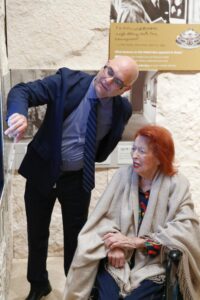
I’ve been interviewing for the J. Paul Getty Trust Oral History Project for several years, and it is a continual pleasure to learn about employees and operations across this large organization. But rarely do I come across a longtime employee whose work for the Getty Trust has taken them across departments, programs, and even physical sites. This is what made my interview with Merritt Price so unique. In fall 2020, I conducted a series of oral history interviews with Merritt Price, the former head of the Design Department (now Museum Design Department, 1995-2020).
Merritt Price is the former head of the Design Department (now Museum Design Department) at the J. Paul Getty Trust, which he ran from 1995-2020. Price grew up in Belleville, Ontario, Canada, and moved to Toronto in 1980 to attend the Ontario College of Art (now Ontario College of Art and Design). Price worked for several design firms in Toronto, including starting his own practice called Tangram, before accepting a position with the Art Gallery of Ontario in 1990. He began his work with the J. Paul Getty Trust in 1995, founding what was then the Exhibition Design Department.
Find this interview and all our oral histories from the search feature on our home page. You can search by name, key word, and several other criteria.
When Merritt Price joined the Getty in 1995, he needed to build the then-Exhibition Design Department from the ground up. This involved defining the Department’s work as not only about aesthetic concerns like text labels and display cases, but also about a larger visitor experience—where museum goers walk and sit, and how they interact with the space. As such, Price assembled a multidisciplinary team to create “one-stop shopping” for design at the Getty Trust.
In thinking about why it was important for the Getty to establish the Design Department, rather than rely on design consultants, Price explained,
“I think it’s also noteworthy that working in-house at a museum, as opposed to being in a consulting office that might be doing design for museums or galleries, that you have a different perspective, because you’re right in it and you’re in it all the time. It’s a little bit more laboratory-like where your work product is right there outside the door in the gallery. You can walk through it, you can see visitors using it.”
Over the twenty-five years he worked at the Getty, Price and his team handled designs for major projects in the organization’s history. Indeed, Price’s first task included design work for the Getty Center, which opened to the public in 1997. In addition to addressing gallery spaces, Price also created a wayfinding system with signposts to orient visitors on the large Getty Center campus. He later worked on the redesigns at the Getty Villa.
Price and his team also designed for exhibitions across the Getty Trust, including Devices of Wonder: From the World in a Box to Images on a Screen, Foundry to Finish: The Making of a Bronze Sculpture, and Michelangelo: Mind of the Master. However, Price was particularly involved in the exhibition J. Paul Getty Life and Legacy, for which he pitched the concept and led a team of curators in creating content. Listen as he explains the idea behind the show:
I have a background in museum work, and I felt confident speaking with Mr. Price about his vision for museum spaces and the practical necessities like spacing around pedestals. However, I still learned a great deal about technical innovations, as well as the impact of design both on exhibitions and on the other spaces in which visitors use—from trams to gift shops to restaurants. This interview was both personally enjoyable and is a great source of information about the construction and redesign of the Getty Center and the Getty Villa.
To learn more about Merritt Price’s life and work, read his oral history transcript here. Find this interview and all our oral histories from the search feature on our home page. You can search by name, key word, and several other criteria.